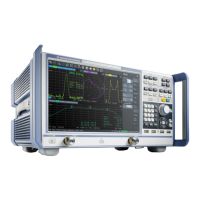Command Reference
R&S
®
ZNB/ZNBT
939User Manual 1173.9163.02 ─ 55
Example:
*RST; :CALCulate1:TRANsform:DTFault:STATe ON
makes the active trace of channel 1 a DtF trace.
SENSe1:SWEep:POINts?
returns the default number of sweep points (201).
:CALCulate1:TRANsform:DTFault:STARt 0; STOP 100
widens the DtF distance window to 100m.
CALCulate1:TRANsform:DTFault:POINts
starts the "Auto Number of Points calculation". Now
SENSe1:SWEep:POINts?
returns an increased number of sweep points.
Usage: Event
Options: R&S ZNB/ZNBT-K3
Manual operation: See "Auto Number of Points" on page 676
CALCulate<Chn>:TRANsform:DTFault:STARt <Start>
CALCulate<Chn>:TRANsform:DTFault:STOP <Stop>
Defines the window of the Distance to Fault measurement using its start and stop dis-
tance.
See also CALCulate<Chn>:TRANsform:DTFault:CENTer and
CALCulate<Chn>:TRANsform:DTFault:SPAN.
Suffix:
<Chn>
.
Channel number used to identify the active trace
Parameters:
<Start>/<Stop> Start/stop distance.
Default unit: m
Example:
:CALCulate1:TRANsform:DTFault:STARt 1; STOP 3
Defines the DtF distance window of the active trace of channel 1
as [1m, 3m].
Options: R&S ZNB/ZNBT-K3
Manual operation: See "Start Distance / Stop Distance" on page 676
CALCulate<Chn>:TRANsform:DTFault:STATe <DtfState>
If channel <Chn> is performing an unsegmented frequency sweep, this command
allows to transform its active trace into a Distance to Fault (DtF) trace.
Suffix:
<Chn>
.
Channel number used to identify the active trace
Parameters:
<DtfState> OFF|ON – DtF disabled|enabled
*RST: OFF
SCPI Command Reference

